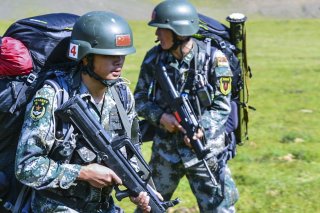Why China Still Remains Faithful to Its Old QBZ-95-1 Assault Rifle
This is not your standard bullpup rifle, and althought it's not well renowned it packs a serious punch.
Here's What You Need to Remember: Despite the increasingly mechanized nature of the People’s Liberation Army, China’s infantry arm is still, as it is in other armies, the “Queen of Battle.” The QBZ-95-1 is a powerful and reliable, although slightly dated, weapon that was emblematic of the military revolution that began in China in the early 1990s and continues to this day.
One of the most widely issued—but least known—infantry small arms is the QBZ-95-1 assault rifle. The QBZ-95-1 is the official rifle of the People’s Liberation Army (PLA) and its various sub-branches, including the People’s Liberation Army Navy Marine Corps. Unorthodox in appearance, the bullpup QBZ-95-1 also fires an unusual 5.8-millimeter cartridge. The result is a unique weapon symbolic of China’s attempt to go its own way in the world of military small arms.
China was one of the largest land powers of the twentieth century—though not exactly the most powerful. The People’s Liberation Army, both before and after the end of the Chinese Civil War, was predominantly an infantry army with millions of trained ground troops. After the civil war, China’s “People’s War” military doctrine stressed defensive wars, in which invaders were lured deep into the Chinese interior and then destroyed by a combination of regular and guerrilla forces.
The 1991 Gulf War, in which a rapidly moving U.S.-led coalition swiftly destroyed a larger Iraqi Army (often equipped with Chinese weapons) was a seismic event in Chinese defense thinking. The People’s Liberation Army was thoroughly revamped, and part of that revamping was the introduction of a new generation of infantry small arms. Older weapons, including the Type 68 and Type 56 assault rifles were retired.
In their place arrived the new QBZ-95-1 series of assault rifles. The QBZ-95-1 is a uniquely Chinese rifle, with a futuristic look that was a clean break from older, Soviet-inspired weapons. The weapon is officially known as the QBZ-95-1 5.8-millimeter assault rifle, with the initials standing for “Light Infantry Weapon, Infantry, Automatic.” The basic ammunition load for PLA troops is 300 rounds, carried in ten 30-round magazines.
The QBZ-95-1 is a bullpup weapon, meaning the action and magazine are all located behind the trigger group. This creates a more compact weapon: although the rifle is just under 30 inches long, it has a barrel with a length of 20 inches, as long as that on a M16A4 assault rifle. That’s 5.5 inches longer than that on the M4A1 carbine and should be good for a slight range increase over the American infantry carbine.
The QBZ-95-1 uses a short stroke, gas piston design, the same as used in rifles such as the M1 Garand and AK-47. In that respect, China’s infantry rifle still maintains its Soviet heritage. Its rate of fire is 650 rounds a minute. The weapon uses iron sights integrated into a carry handle running along the upper portion of the receiver. Although some rifles have been observed with optical sights installed on the carry handle, the already high height over bore of the mounting site makes add-on optic integration less than ideal.
Unlike U.S., NATO, and Russian assault rifles that use 5.56 or 5.45-millimeter cartridges, the Chinese weapon uses a locally designed 5.8x42 round. Exactly why China chose to develop an entirely new round is unknown, although it could be for security reasons. The 5.8-millimeter round offers improved ballistics performance over the U.S. Army’s 5.56-millimeter M855 round when that round is fired from the M4A1 carbine. This may be a function of the slightly larger round, pushed by slightly more propellant out of a longer (20” vs. 14.5”) barrel.
The QBZ-95-1 is issued with a bayonet and, along with six WY-91 hand grenades, forms the firepower of the average PLA soldier. Each nine man PLA squad has two fire teams, with one grenadier per fire team. The grenadier carries a QBZ-95-1 equipped with a 35-millimeter underbarrel grenade launcher similar in concept to the long-serving U.S. Army M203 grenade launcher. The grenadier also carries an additional fifteen rifle grenades. A heavier QBB-95 light support weapon features a bipod and 75-round magazines for laying down suppressive fire.
Despite the increasingly mechanized nature of the People’s Liberation Army, China’s infantry arm is still, as it is in other armies, the “Queen of Battle.” The QBZ-95-1 is a powerful and reliable, although slightly dated, weapon that was emblematic of the military revolution that began in China in the early 1990s and continues to this day.
Kyle Mizokami is a defense and national-security writer based in San Francisco who has appeared in the Diplomat, Foreign Policy, War is Boring and the Daily Beast. In 2009 he cofounded the defense and security blog Japan Security Watch. You can follow him on Twitter: @KyleMizokami. (This first appeared several months ago.)
Image: Wikipedia.

